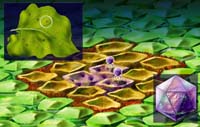How cell suicide protects plants from infection

A protective zone of dead cells (brown) around a virus invasion (purple) halts the spread of virus. Credit: Nicolle Rager Fuller, NSF
Researchers at Yale have identified a gene that regulates the major immune response in plants, programmed cell death (PCD), according to a recent report in the journal Cell.
To protect themselves from viruses, plants create a zone of dead cells around an infection site that prevents the infection from spreading. Savithramma Dinesh-Kumar, associate professor of Molecular, Cellular and Developmental Biology at Yale and his colleagues discovered how the plants keep from killing themselves after they turn on the cell-suicide PCD process.
Dinesh-Kumar first developed a technique for silencing or inactivating plant genes — a technique that is now used by several research groups. His group studies the interaction between plants and viruses using tobacco as a model system.
They identified and silenced a “pro-survival” gene, BECLIN-1, that is important in the PCD response. When BECLIN-1 is active, infection is localized to a small number of cells that later die and form discrete brown lesions on the leaves. When the gene is inactivated, the plant can no longer regulate PCD, leading to cell death throughout the leaf and plant.
PCD has been described in virtually all cell types, both plant and animal. It is an important aspect of many biological processes including immune system function, embryonic development and elimination of defective cells. Failure of PCD can result in devastating diseases such as cancer, Alzheimer’s and AIDS.
“This work gives us a better understanding of how plants fend off microbial attacks through carefully controlled destruction of infected cells,” said James Anderson, of the Division of Genetics and Developmental Biology at the National Institute of General Medical Sciences (NIGMS). “Like other studies carried out in model organisms, these findings shed light on similar processes that occur in mammals, and may eventually be used to better human health.”
Media Contact
More Information:
http://www.yale.eduAll latest news from the category: Life Sciences and Chemistry
Articles and reports from the Life Sciences and chemistry area deal with applied and basic research into modern biology, chemistry and human medicine.
Valuable information can be found on a range of life sciences fields including bacteriology, biochemistry, bionics, bioinformatics, biophysics, biotechnology, genetics, geobotany, human biology, marine biology, microbiology, molecular biology, cellular biology, zoology, bioinorganic chemistry, microchemistry and environmental chemistry.
Newest articles

Properties of new materials for microchips
… can now be measured well. Reseachers of Delft University of Technology demonstrated measuring performance properties of ultrathin silicon membranes. Making ever smaller and more powerful chips requires new ultrathin…

Floating solar’s potential
… to support sustainable development by addressing climate, water, and energy goals holistically. A new study published this week in Nature Energy raises the potential for floating solar photovoltaics (FPV)…

Skyrmions move at record speeds
… a step towards the computing of the future. An international research team led by scientists from the CNRS1 has discovered that the magnetic nanobubbles2 known as skyrmions can be…





















